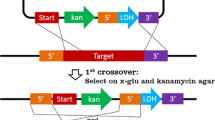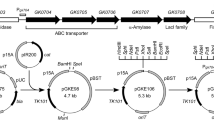Summary
Wild-type strains ofZymomonas mobilis have a limited substrate range of glucose, fructose and sucrose. In order to expand this substrate range, transconjugants ofZ. mobilis containing Lac+ plasmids have been constructed. Although β-galactosidase is expressed in such strains, they lack the ability to grow on lactose. We now report the development ofZ. mobilis strains capable of growth on lactose. This was achieved in two stages. First, a broad host range plasmid was constructed (pRUT102) which contained the lactose operon under the control of aZ. mobilis promoter plus genes for galactose utilization.Z. mobilis CP4.45 containing pRUT102 was then subjected to mutagenesis combined with continued selection pressure for growth on lactose. One strain,Z. mobilis SB6, produced a turbid culture that yielded 0.25% ethanol from 5% lactose (plus 2% yeast extract) in 15 days.
Similar content being viewed by others
References
Ahmed, A. 1984. Plasmid vectors for positive galactose-resistance selection of cloned DNA inEscherichia coli. Gene 28: 37–43.
Bagdasarian, M. and K.N. Timmis. 1981. Host-vector systems for gene cloning inPseudomonas. Curr. Topics. Microbiol. Immunol. 96: 47–67.
Buchholz, S.E. and D.E. Eveleigh. 1986. Transfer of plasmids to an antibiotic-sensitive mutant ofZymomonas mobilis. Appl. Environ. Microbiol. 52: 366–370.
Buchholz, S.E., P. O'Mullan and D.E. Eveleigh. 1988. Growth ofZymomonas mobilis CP4 on mannitol. Appl. Microbiol. Biotechnol. (in press).
Carey, V.C., S.K. Walia and L.O. Ingram. 1983. Expression of a lactose transposon (Tn951) inZymomonas mobilis. Appl. Environ. Microbiol. 45: 1163–1168.
Carr, J.G. 1981. The genusZymomonas. In: The Prokaryotes; a Handbook on Habitats, Isolation and Identification of Bacteria, Vol. 2 (Starr, M.P., H.G. Truper, A. Balows and H.G. Schlegel, eds.), pp. 1349–1354, Springer-Verlag, New York.
Chun, U.H. and P.L. Rogers. 1986. Kinetic studies on aLac-containing strain ofZymomonas mobilis. Biotechnol. Lett. 8: 807–810.
Cornelis, G., D. Ghosal and H. Saedler. 1978. Tn951: a new transposon carrying the lactose operon. Mol. Gen. Genet. 160: 215–224.
Dawes, E.A., D.W. Ribbons and P.J. Large. 1966. The route of ethanol formation inZymomonas mobilis. Biochem. J. 98: 795–803.
Dooley, M.M. and S.E. Buchholz. 1987. Fermentation of lactose byZymomonas mobilis: genetic approaches. Annu. Meet. Am. Soc. Microbiol. (Atlanta, Ga), Abstr. O-28.
Eveleigh, D.E., H.W. Stokes and E.L. Dally. 1983. Recombinant DNA approaches for enhancing the ethanol productivity ofZymomonas mobilis. In: Organic Chemicals from Biomass (Wise, D.L., ed.), pp. 69–91, Benjamin/Cummings, Menlo Park, CA.
Freifelder, D. 1987. Molecular Biology: a Comprehensive Introduction to Prokaryotes and Eukaryotes, 2nd Ed. Jones and Bartlett Publishers, Boston, MA.
Goodman, A.E., P.L. Rogers and M.L. Skotnicki. 1982. Minimal medium for isolation of auxotrophicZymomonas mutants. Appl. Environ. Microbiol. 44: 496–498.
Goodman, A.E., A.T. Strzelecki and P.L. Rogers. 1984. Formation of ethanol from lactose byZymomonas mobilis. J. Biotechnol. 1: 219–228.
Grote, W., L.J. Lee and P.L. Rogers. 1980. Continuous ethanol production by immobilized cells ofZymomonas mobilis. Biotechnol. Lett. 2: 481–486.
Kaback, H.R. 1985. Proton electrochemical gradients and active transport: the saga oflac permease. Ann. N.Y. Acad. Sci. 456: 291–304.
Krug, T.A. and A.J. Daugulis. 1983. Ethanol production usingZymomonas mobilis immobilized on an ion exchange resin. Biotechnol. Lett. 5: 159–184.
Lawford, G.R., B.H. Lavers, D. Good, R. Charley, J. Fein and H.G. Lawford. 1983.Zymomonas ethanol fermentations: biochemistry and bioengineering. In: Ethanol from Biomass International Symposium (Duckworth, H.E. and E.A. Thompson, eds.), pp. 482–507, Royal Society, Canada, Ottawa.
Maniatis, T., E.F. Fritsch and J. Sambrook. 1982. Molecular Cloning. Cold Spring Harbor Laboratories. Cold Spring Harbor, NY.
McGhee, J.E., G.St. Julian, R.W. Detroy and R.J. Bothast, 1982. Ethanol production by immobilizedSaccharomyces cerevisiae, Saccharomyces uvarum andZymomonas mobilis. Biotechnol. Bioeng. 29: 370–382.
Miller, J.H. 1972. Experiments in Molecular Genetics. Cold Springer Harbor Laboratories, Cold Spring Harbor, NY.
Millis, N.F. 1956. A study of cider-sickness bacillus—a new variety ofZymomonas anaerobia. J. Gen. Microbiol. 15: 521–528.
Montenecourt, B.S. 1985.Zymomonas, a unique genus of bacteria. In: Biology of Industrial Microorganisms (Demain, A.L. and N.A. Solomon, eds.), pp. 261–289, Benjamin/Cummings, Menlo Park, CA.
Palva, E.T. and T.J. Silhavy. 1984.lacZ fusions to genes that specify exported proteins: a general technique. Mol. Gen. Genet. 194: 388–394.
Perbal, B. 1984. A Practical Guide to Molecular Cloning. John Wiley and Sons, New York.
Pugsley, A. P. and M. Schwartz. 1985. Export and secretion of proteins by bacteria. FEMS Microbiol. Rev. 32: 3–38.
Rogers, P.L., K.J. Lee, J.H. Lee and M.L. Skotnicki. 1984. Recent developments in theZymomonas process for ethanol production. CRC Crit. Rev. Biotechnol. 1: 273–288.
Rogers, P.L., K.J. Lee and D.E. Tribe. 1979. Kinetics of alcohol production byZymomonas mobilis at high sugar concentrations. Biotechnol. Lett. 1: 165–170.
Romano, A.H. 1986. Microbial sugar transport systems and their importance in biotechnology. Trends Biotechnol. 4: 207–213.
Stokes, H.W., E.L. Dally, M.D. Yablonsky and D.E. Eveleigh. 1983. Comparison of plasmids of strains ofZymomonas mobilis. Plasmid 9: 138–146.
Strzelecki, A.T., A.E. Goodman and P.L. Rogers. 1986. Stability of thelac operon inZymomonas mobilis in batch and continuous culture. J. Biotechnol. 3: 197–205.
Swings, J. and J. De Ley. 1977. The biology ofZymomonas. Bacteriol. Rev. 41: 1–46.
Vieira, J. and J. Messing. 1982. The pUC plasmids, an M13mp7-derived system for insertion mutagenesis and sequencing with synthetic universal primers. Gene 19: 259–268.
Yanase, H., M. Yasui, T. Miyazaki and K. Tonomua. 1985. Fusion of spheroplasts and genetic recombination ofZymomonas mobilis. Agric. Biol. Chem. 49: 133–140.
Author information
Authors and Affiliations
Rights and permissions
About this article
Cite this article
Buchholz, S.E., Dooley, M.M. & Eveleigh, D.E. Growth ofZymomonas on lactose: Gene cloning in combination with mutagenesis. Journal of Industrial Microbiology 4, 19–27 (1989). https://doi.org/10.1007/BF01569689
Received:
Revised:
Accepted:
Issue Date:
DOI: https://doi.org/10.1007/BF01569689




